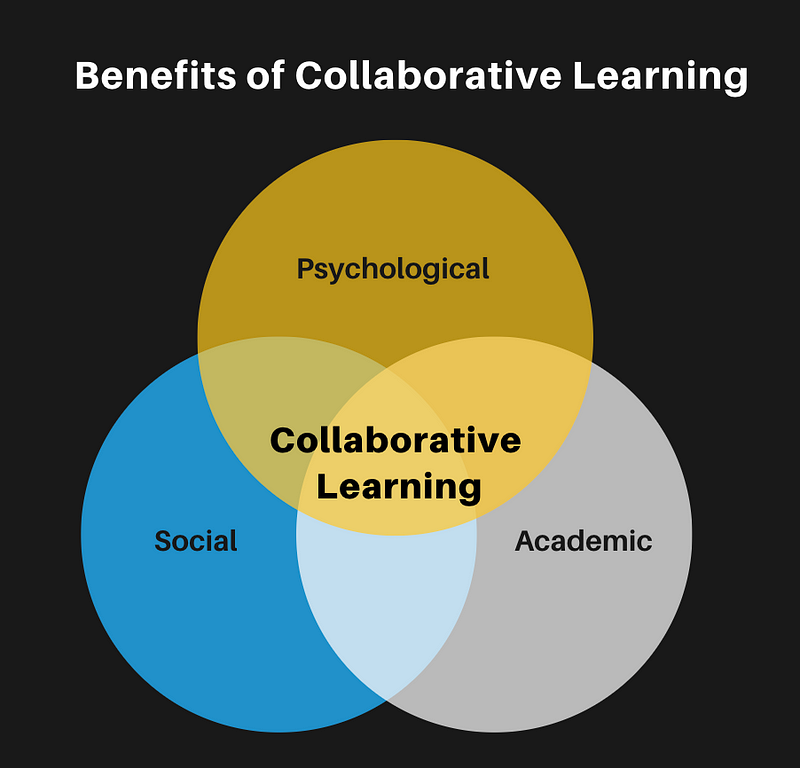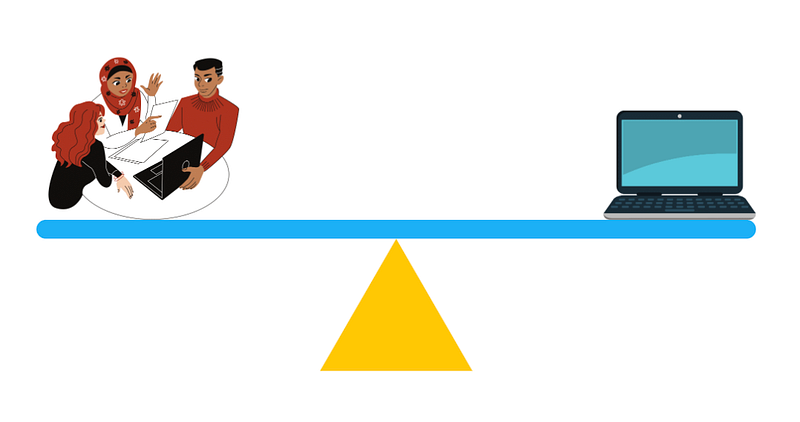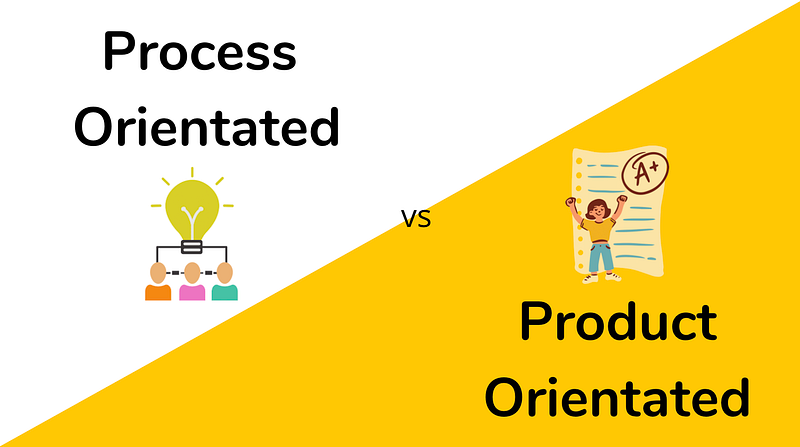Collaborative Learning
Collaborative Learning
The Social, Psychological and Academic Benefits
To most, learning might seem like a personal journey.
A solo endeavour, based on your own individual goals, to attain knowledge about specific topics or fields.
It doesn’t need to be though. Collaboration in learning has been — and is still being — used extensively in classrooms, training centres and online.
Collaborative learning has been shown to have remarkable benefits to us as individuals, and to the way we learn. It’s something worth leaning into with a positive mindset, rather than shying away from.
“If you want to go fast, go alone. If you want to go far, go together.” — African Proverb

What is Collaborative Learning?
Collaborative learning, as the name suggests, is an approach to learning that utilises collaboration in order to reach learning goals. This approach to learning actively engages learners in a way that helps them understand and investigate information and concepts such that they may learn it better.
“Coming together is a beginning. Keeping together is progress. Working together is success.” – Henry Ford
Collaborative learning is divergent from competitive learning — where learners work against each other to achieve a goal that only a few can attain — and individualistic learning — where learners work on their own to accomplish goals unrelated to the goals of others.
I felt that the definition of this approach to learning in the Valamis publication hit the nail on the head. So rather than paraphrasing, here it is, straight from the source:
“Collaborative learning is the educational approach of using groups to enhance learning through working together. Groups of two or more learners work together to solve problems, complete tasks, or learn new concepts.
Through defending their positions, reframing ideas, listening to other viewpoints and articulating their points, learners will gain a more complete understanding as a group than they could as individuals.” — Valamis, 2021

At the heart of it, collaborative learning involves working together to reach shared learning goals.
What does this look like in practice though?
Collaborative Learning in Practice
At a high level, any exercise that involves interaction between two or more people with the shared purpose of learning something new can be considered collaborative.
This might include group projects, brainstorming sessions, problem-solving exercises, discussions, debates, and many other forms. It requires active participation by the learners involved and might involve learners becoming teachers at times.
The setting and environment created are important foundations of collaborative learning, and play a role in how the experience is perceived by the learners.
To foster a successful collaborative learning environment — and other working environments in general — respect is required and must be given to every member. Learners need to feel both safe and challenged in order to learn, grow and feel comfortable participating. Creating this kind of environment needs to be at the foundation of any program and exercise design.

Diversity and different perspectives are celebrated in collaborative learning, where each new point of view provides learners with an opportunity to reassess and expand on their understanding of a topic. Because of this kind of engagement, learners benefit most from this kind of learning if they adopt a growth mindset, and keep an open mind.
If a healthy and welcoming learning environment is created, and students feel challenged and safe, the benefits of collaborative learning can begin to work their magic.
The Benefits of Collaborative Learning
When implemented correctly, these benefits can be extensive.
They extend further than simply helping us to reach our learning goals, and have strong positive social and psychological impacts on us as learners.
“Collaboration is like carbonation for fresh ideas. Working together bubbles up ideas you would not have come up with solo, which gets you further faster.” — Caroline Ghosn

Laal and Gohdsi, 2011, compiled a fascinating review article on the benefits of this learning approach. Some of the key takeaways include: higher achievement and greater productivity; more caring, supportive, and committed relationships; and greater psychological health, social competence and self-esteem. These are grouped and outlined as follows:
1- Social benefits
From a social perspective, the benefits of collaborative learning are derived from the interaction with, and working alongside other learnings. These benefits include:
- helping to develop a social support system for learners;
- building diversity in understanding among students and staff;
- establishing a positive atmosphere for modelling and practising cooperation, and;
- developing learning communities.
Bringing people together to work together to reach a shared goal provides a structured and positive environment for building social relationships.
Building a learning community and having people available to support you and challenge you, helps us grow not only in an academic sense but in a social sense as well. We as humans are, after all, social beings.

2- Psychological Benefits
Not only does collaboration have social benefits for those involved, but the benefits can also be psychological i.e. good for our mental and emotional state of being. These include benefits such as:
- Increasing student’s self-esteem as a result of student-centred instruction;
- Reducing anxiety as a result of cooperation;
- Developing positive attitudes of the students towards teachers.
Ultimately these benefits lead to a more positive learning experience. And, given the power of the mind and the impact of our state of being on the way we experience the world, this leaves us more likely to engage deeply and return in future. We’re also more likely to learn things when we’re in the right state of mind. Collaborative learning helps to promote these states of mind.
3- Academic Benefits
The main goal of any learning approach should, at its core, help learners to learn things better.
Collaborative learning does just that.
Stacked with the social and psychological benefits, the interactivity and engagement it promotes help boost academic performance, and has the following benefits:
- Collaborative Learning promotes critical thinking skills;
- It involves students actively in the learning process;
- Academic results are improved;
All in all, compared to the traditional lecturer-student one-sided interaction, interactive learning has some fantastic benefits and advantages. It is something which can be utilised for both students in the classroom and for professionals at the workplace.
Is it applicable to the digital age though?
Lockdowns. Zoom calls. Online courses. And the shift out of the traditional classroom and onto our devices that has occurred over the past 2 years.
Can we still make use of collaborative learning in an online setting?

Collaborative learning in the Digital Age
Collaboration makes sense in a physical classroom, where we can sit alongside our peers and make progress together.
What about when we’re all online?

In the modern digital age, with technology and the connectedness that comes with it, we have instant access to anything and anyone around the globe. The vast majority of us aren’t researching and learning novel things, and the chances are pretty high that among the 4.66 billion people with internet access, and over 220 million MOOC learners, that there is someone that has learnt or is currently learning the same thing as you.
That gives each of us the opportunity to make use of collaboration in order to reach our learning goals. Even when online.
Collaborative learning is not only viable in an online learning environment, but it is also a key way to keep learners engaged, motivated and progressing!
There are two ways to group the collaborative learning that takes place online: process-orientated and product-orientated.

Process-orientated collaboration encapsulates discussions, interactions, and sharing of ideas related to course content and learning material. These discussions may not lead to a specific product. This can take place on discussion forums, commenting on online course content and engaging with other learners in an online setting.
Process-orientated collaboration is extremely versatile online and can present some advantages over classroom discussions. It is this form of online collaboration that goes hand in hand with the building of learning communities.
Product-orientated collaboration on the other hand generally aims towards the completion of a specific product, such as a project or essay etc. This form of collaboration, although still possible and effective, has received some mixed research results — with some learners being less enthusiastic about online in comparison to classroom-based.
So yes, Collaborative Learning is possible online. And with our hands being forced the move to the digital learning world, it is exciting to see that we can still extract the benefits of it.
Takeaways
We as humans are social beings, and learning is an inherently social activity as well. We derive significant value from collaborative environments and working together to achieve our goals. This is true for learning as well.
By working together with others, we are able to expand our understanding of topics, see different perspectives, engage more deeply in material and build our own personal learning communities.
It is these learning communities and the collaboration that they allow that brings with it social, psychological and academic benefits that we can’t attain on our own.
Collaboration should be something that we look to incorporate into learning programs both in the classroom and online. If the programs and platforms are structured correctly and the right environments are created, learners are able to thrive in collaborative settings.
Want to build your own online learning community?
At Beeline, we see learning as both a personal, professional, collaborative and social endeavour and provide you with a platform to find, connect with and grow your learning community.
The platform is now live and free for the public to use and grow their learning communities. We also have private organisation workspaces for companies that are looking to build their culture of collaboration, learning, development. Check it out! 🐝
Frequently Asked Questions (FAQs)
1 — How does collaborative learning enhance the learning experience in both traditional and digital settings?
Collaborative learning enriches the educational journey by fostering a supportive environment where individuals can share insights, challenge perspectives, and build knowledge collectively, applicable in both traditional classrooms and online platforms.
2 — What are the key benefits of incorporating collaborative learning into educational programs?
Incorporating collaborative learning into programs offers multiple advantages, including enhanced critical thinking, improved social skills, and higher academic achievement, by leveraging the collective knowledge and experience of the group.
3 — How can Beeline facilitate the creation and growth of online learning communities to support collaborative learning?
Beeline supports the development of online learning communities by providing tools for connection and collaboration, enabling learners to interact, share resources, and work together towards common learning objectives, thereby enriching the collective learning experience.